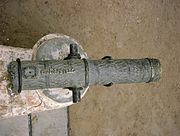Battle of Kousséri
| Battle of Kousséri | |
|---|---|
| Part of the Rabih War (1899–1901) | |
Cameroun | |
| Result | French victory |
(French sources)
800 Baguirmians
3,000 wounded
(Including civilians)
75 wounded
The battle of Kousséri originated in French plans to occupy the
Prelude
In 1899,
In 1899, Rabih received in
In response, a French column proceeding from
Battle
The final showdown between Rabih and the French took place on April 22, 1900. The French forces consisted of 700 troops, plus the 600 riflemen and 200 cavalry provided by the allied Baguirmians. Leaving Kousséri the French in three columns attacked Rabih's camp, and in the ensuing battle, the French commander Major Amédée-François Lamy was killed. However, Rabih's forces were overwhelmed and, while attempting to flee across the Chari River, Rabih was shot in the head by a skirmisher from the Central Africa mission. Hearing there was a bonus for Rabih's corpse, the skirmisher returned to the field and brought back Rabih's head and right hand.
The casualties amounted to 28 dead and 75 wounded on the French side; 1,000 to 1,500 dead and more than 3,000 wounded on Rabah's side, including women and children accompanying the army.
Significance
With the defeat of Rabih's forces, the French ensured their control over most of Chad, which became part of the
Gallery
-
Rabih's head, a battlefield trophy after the fighting.
-
Rabih's battle flags, captured by the French after the battle.
-
One of Rabih's cannons captured by the French.
References
- ISBN 0-393-04770-9pp. 466–467
- Robin Hallett . Africa Since 1875: A Modern History. University of Michigan (1974) ISBN 0-472-07170-Xp. 444
- Victor T. Le Vine, Roger P. Nye. Historical Dictionary of Cameroon. Scarecrow Press (1974) ISBN 0-8108-0707-6
- James Stuart Olson, Robert Shadle, Ross Marlay, William Ratliff, Joseph M. Rowe. Historical Dictionary of European Imperialism. Greenwood Publishing (1991) ISBN 0-313-26257-8pp. 123–124



